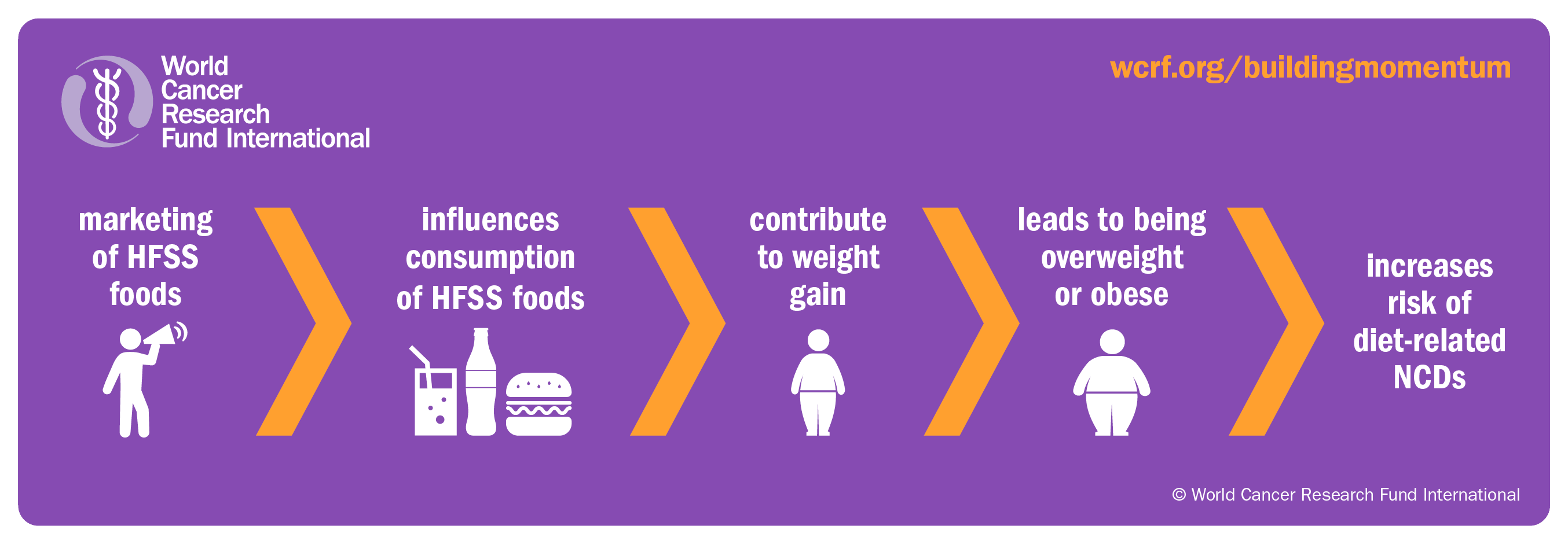Professor Amandine Garde highlights the growing recognition of unhealthy food marketing as a major children’s rights issue, and what can and should be done to address it
Ten years after the adoption of the World Health Organization (WHO) Recommendations on the marketing of foods and non-alcoholic beverages to children, children around the world remain exposed to high levels of unhealthy food marketing. This is worrying, as food marketing has been directly associated with unhealthy diets, malnutrition and child obesity. Children who are overweight or obese are more likely to be overweight or obese adults, which increases their risk of at least 12 different types of cancer.
Nevertheless, there are reasons to be cautiously optimistic. Not only is the discourse on food marketing changing, but a growing number of useful, practical tools are now available to facilitate the implementation of the WHO Recommendations, the most recent being World Cancer Research Fund’s (WCRF) third report in their Building Momentum series. The next decade is likely to witness the adoption of more effective restrictions on the marketing of unhealthy food to children.
The discourse – food marketing as a child rights concern
In the last five years, a consensus has developed that food marketing should not be seen exclusively as a public health issue but also as a major child rights concern. Academic research, policy analysis and high-level statements have supported each other to establish that the marketing of unhealthy food to children infringes many of the rights of the child enshrined in the UN Convention on the Right of the Child (CRC) and other international human rights instruments. These rights include the right to health, the right to food and the right to development, as well as – in the context of digital marketing – the right to privacy and the right to be free from exploitation.
One of the main advantages of adopting a child rights approach to food marketing is that it increases the accountability of States, as duty bearers, to ensure that children, as rights holders, are effectively protected from the harm associated with unhealthy food marketing. Under the CRC, States have legally binding obligations to promote the enjoyment of the highest attainable standard of health by all children.
It is increasingly clear that this responsibility should not be delegated to the food and advertising industries through self-regulation. These industries are unlikely, irrespective of their rhetorical statements to the contrary, to engage in “responsible marketing” to children in the absence of the hard stick that the law can provide. Industry-led, voluntary pledges are riddled with loopholes (for example, several media and marketing techniques fall outside their scope and children are only “protected” if they are below the age of 12), and as a result of the inherent problems associated with public-private partnerships in this policy area, they have failed to protect children from harm.
WCRF explicitly embraces a child rights-based approach in its third Building Momentum report, echoing the advocacy brief on Protecting Children’s Right to a Healthy Food Environment that UNICEF and the Special Rapporteur on the Right to Food published together to celebrate the 30th anniversary of the CRC in November 2019.
The practical tools for more effective marketing restrictions
However, providing robust arguments that marketing should be effectively regulated is only the first part of the battle. Once the political will is sufficient for governments to implement marketing restrictions, they need to know how to act to ensure that the measures they adopt achieve their intended objective, and to defend these measures if they are challenged before courts of law by the food industry worried about the impact on their profit margins.

It is now clearly established that, if regulatory frameworks focus exclusively on broadcast media, advertising investments will shift from regulated to unregulated media, and in particular to digital media. Hence the insistence, grounded in evidence, of UNICEF and the WHO (see guidance for the Europe Region, Eastern Mediterranean and Western Pacific) that only a comprehensive implementation of the WHO Recommendations can achieve their objective of reducing the impact on children of unhealthy food marketing. WCRF’s third Building Momentum report reviews the different components that governments should consider when defining the scope of their new restrictions. Let us hope that the Committee on the Rights of the Child currently working on a General Comment on children’s rights in relation to the digital environment amplifies these calls on States to effectively regulate the digital marketing of unhealthy food (as well as alcohol, tobacco, gambling and other such commodities and services which harm the development of the child).
Governments should also prepare for possible legal challenges when implementing marketing restrictions: the more comprehensive the rules they adopt, the more likely industry is to argue that these rules are unlawful. We have learnt from tobacco control that challenges can take different forms and that they are part of the intimidation tactics industry have used to detract governments from imposing unwelcome restrictions on how they manufacture, distribute and promote their goods. Hence the importance of building the legal capacity of governments and civil society to better anticipate and respond to these challenges. Highlighting this imperative is another major contribution of WCRF’s third Building Momentum report. In particular, it draws lessons from several case studies, comparing existing regulatory frameworks and highlighting the opposition governments have faced and how such opposition may be overcome.
As WCRF notes, we can now look forward to the forthcoming publication by the WHO and UNICEF of a guidance tool on what they understand a child rights implementation of the WHO Recommendations entails, in light of the evidence that has accumulated this last decade on both the harm associated with unhealthy food marketing and how to regulate such marketing. This renewed collaboration on nutrition of the two UN agencies primarily responsible to promote child health bodes well for the future: the more the UN speaks with one voice, the more this voice may be heard. Perhaps the commitments of the international community to promote healthy nutrition, healthy ageing and sustainable development provides the additional impetus that governments need to finally restrict the marketing of unhealthy food to protect child health and child rights.











